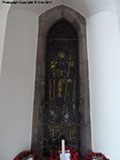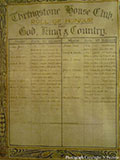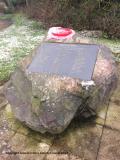Corporal James Bancroft, 240636
- Batt - 8
- Unit - Leicestershire Regiment
- Section -
- Date of Birth - 1896
- Died - 21/03/1918
- Age - 22
Add to this record?
If you have photographs, documents or information that can contribute to this record, you can upload here
ContributeSource: Michael Doyle Their Name Liveth For Evermore: The Great War Roll of Honour for Leicestershire and Rutland. He was the son of John Bancroft a Below Ground Coal Miner, Stallman, born 1868 in Thringstone, Leicestershire and his wife Emma, born 1870 in Thringstone, Leicestershire. James was born in 1896 in Thringstone, Leicestershire, his siblings were William, born 1893, Ellen, born 1894, John Cyril, born 1900, Laura, born 1901, Reginald, born 1904 and Florence, born 1906, all his siblings were born in Thringstone, Leicestershire. In March 1901 the family home was at Grace View Road, Thringstone, Leicestershire. In April 1911 James was employed as an Above Ground Colliery Labourer and was residing in the family home at St. John Street, Thringstone, Leicestershire with his widowed mother and siblings, William, John Cyril, Laura, Reginald and Florence. James was a regular attendee at St. Andrew’s Church in Thringstone. He enlisted in the 5th Battalion of the Leicestershire Regiment and embarked for France. During 1915 he was wounded and first treated in France before being hospitalised in England. On his recovery he was transferred to the 8th Battalion of the Leicestershire Regiment at that time being part of the 110th Brigade of the New Army. The Battalion was in trenches at Epehy on the Cambrai front, when the Germans launched their huge Spring Offensive on the 21st March 1918. At 2.30am the 110th Brigade was shaken by a heavy enemy barrage of both high explosive and shrapnel shells. As dawn broke thousands of German storm troopers attacked through the mist and drove the Leicestershire soldiers back. Throughout the day the battle raged in Epehy, hand to hand fighting from one street to the next, with ruined houses and cellars proving excellent cover for both sides, especially snipers. As the cover of night descended the enemy launched another heavy barrage to prevent allied reinforcements from reaching the battlefront, and eventually the town fell into German hands. Those of our troops that managed to escape began a long and weary retreat – sleeping in ditches and constantly being harassed by shell fire. It is no longer possible, if ever to learn what happened to James who lost his life on that fateful day. The War Diary entry for events from the 17th to the 21st March 1918 records. FRONT LINE, EPEHY. The Battalion moved into the front line on the night of March 17th, relieving the 6th LEICESTERSHIRE REGT. The enemy’s attitude still remained abnormal, and prisoners obtained by means of raids gave the date for the attack as the 21st or 22nd. Hostile patrols were seen or encountered in no mans land and the extraordinary inactivity of the hostile artillery was still maintained. The weather was extremely fine, and had been so for the previous week, under the warm and continued sunshine, the ground became very dry and firm, heavy ground mists were prevalent during the early mornings. At 1.00am on the morning of the 21st March, a patrol of 1 officer and 20 other ranks was sent out by “C” Company to obtain an identification. This patrol met with no opposition whatever and on his return the officer in charge was able to report that not a single German had been seen. At 4.30am the hostile shelling ended its long period of inactivity and commenced a heavy bombardment of the Divisional front and to the north and south, high explosive and large quantities of gas shell were used on the front line system, the village of EPEHY and the Batteries. Very heavy shelling of villages in our back areas also took place, and it quickly became evident that the artillery preparation for an attack on a large scale was in progress. The gas bombardment was particularly severe, mustard gas being used, all ranks were compelled to wear their box respirators for at least 3 hours. When daylight came just after 6.00am it was quite impossible to see the wire in front of the trenches on account of the thickness of the mist, a great disadvantage was thus experienced, the necessity for good observation being absolutely vital to the defenders. Towards 9.00am the hostile artillery lifted the greater part of the fire from our front line system, and placed a -?- barrage west of EPEHY on the Battery positions and all approaches. Telephone communications with two of the front line Companies “C” and “D” were still working and no enemy impending attack had been reported, the thick mist still continued and observation was impossible. During the preparatory bombardment very few casualties were sustained by the Battalion and all ranks were fully prepared for the appearance of the hostile infantry. At 9.30am the enemy infantry advanced to the attack, in accordance with the order to man battle stations the front line garrison had been withdrawn to the immediate support line, and the attack on the Battalion sector was everywhere repelled with heavy loss to the enemy. The enemy was content to hold for the line, our original front line, where he was subjected to a heavy and accurate rifle grenade and Lewis gun fire. Visibility still continued to be impossible and Forward Observation Officers were unable to inform their Batteries of the position of the hostile infantry or even give any clear idea of the situation. During the course of the morning the mist lifted slightly and at intervals strong forces of the enemy could be seen advancing towards ROHNSOY and LEMPIRE on our right. The 16th Division on our right were compelled to withdraw some distance to conform with the line on their right. Strong bombing attacks were made against our right flank held by “A” Company, on two occasions the enemy forced their way into “A” Company’s trenches, but were immediately ejected by vigorous counter bombing. Towards 1.00pm a lull occurred in the fighting on the Battalion front and meanwhile the mist had cleared. Large forces of the enemy could be seen moving west through ROHNSOY and LEMPIRE, and large concentrations of his infantry were seen massing in the valleys east of our front line and in the neighbourhood of VAUCELETTE FARM and VILLERS GUISLAIN. During the afternoon reports received showed that the enemy has broken through our defensive system on the right and were advancing rapidly, the enemy was everywhere held on the 110th Brigade front. Towards 5.00pm the enemy commenced to trench mortar the support line, the fire being heavy and accurate, and at 6.00pm a withdrawal was made to the RED LINE just east of EPEHY to conform with the 7th LEICESTERSHIRE REGT on our left who had been driven out of their support line and to link up with the left Battalion of the 16th Division on our right. The night of March 21st/22nd March passed without any further attack on the front of the hostile infantry, but the enemy artillery displayed great activity during the night chiefly on the approaches to EPEHY and the back areas.
Source: Leicestershire War Memorials Project. Coalville Times article - Friday May 21st, 1920
THRINGSTONE WAR MEMORIAL
UNVEILED BY COL. BOOTH AT THE PARISH CHURCH
A beautiful stained-glass window has been placed in St. Andrew’s Church, Thringstone, in memory of men from the parish who fell in the war, together with a brass tablet bearing all the names, and the unveiling was performed by Col. T. Booth at a special service last Sunday afternoon, when there was a crowded congregation, which included many relatives of the deceased soldiers.
The service was impressively conducted by the Vicar (the Rev. C. Shrewsbury) and opened with the singing of the hymn, “There is a Land of pure Delight.” Other hymns sung were, “O God our help in ages past,” “The Saints of God,” and “For all the Saints,” also the psalm, “The Lord is my Shepherd.”
The window, which faces the church entrance, depicts St. Alban, the first British martyr to die for the Christian faith, and inscribed, “Christ’s faithful soldier and servant unto his life’s end.”
The tablet by the side of the window bears the inscription, “To the greater glory of God, and in memory of the following who from this parish and congregation have given their lives for their country in the great war 1914 – 1919, this window is dedicated by the congregation and parishioners of St. Andrew’s.”
Here are 27 names, as follows:
1914
Pte. T. Jones, Durham Light Infantry.
1915
Pte. E. Hall, Leicestershire
Corp’l W. E. Moore, R.G.A.
Pte. I. Hall, Leicestershire
1916
Pte. E. Howe, Leicestershire
Sapper E. Robinson, Royal Engineers
Pte. L. Whitmore, Leicestershire
Pte. T. Squires, Leicestershire
Pte. M. Grainger, Leicestershire
1917
Pte. F. B. Bowler, Royal Dublin Fusiliers
Pte. R. Freeman, Leicestershire
Sapper H. Briers, Royal Engineers
A. J. Turner, telegraphist, Royal Naval Volunteer Reserve
Pte. J. Squires, Leicestershire
Pte. L. Haywood, Scottish Rifles
Corp’l W. Sykes, Leicestershire
Pte. T. Bailey, Royal Scots
1918
Corp’l J. Bancroft, Leicestershire
Rfn. G. W. W. Howe, Rifle Brigade
Pte. J. Gee, York and Lancaster
2nd Lieut. T. F. McCarthy, Loyal North Lancashire
Pte. S. R. Dring, Leicestershire
J. T. Fortnam, Able Seaman, Royal Naval Division
L.-Corp’l A. Griffin, Sherwood Foresters
Pte. J. Morley, Suffolk
Pte. H. Freeman, Leicestershire
Pte. H. Lakin, Leicestershire
At the foot appear the words: “Greater love hath no man than this, that a man lay down his life for his friends.”
Having unveiled the memorial, Col. Booth proceeded to the other end of the church and from the chancel steps addressed the congregation as follows:
“My friends, I have been entrusted with the very solemn, but to me, the very proud duty, of coming here to address you, the members of this congregation on the subject of the memorial, that beautiful brass tablet which I have just had the honour to unveil, and I can assure you all that I am fully alive to the responsibility which that has involved upon me, and I am also very appreciative of the honour which it has imposed upon me. I am sure that as you heard those names read out, you could not fail to have been impressed, as I was, with the fact that these precious lives came from every class and from all ranks. What you may not have realised altogether is the width and scope of their sacrifice. I will try to explain what I mean. Reading out those names, I first find mention of men who went out at the start, in 1914, to help to stem the first wild onslaught of the Germans before we were ready; when everything was unprepared. Think of that. Then we pass on to other names of men who gave their lives in 1915, in those dull days in the trenches, when everything seemed dark, and when we appeared to be hammering our heads against a stone wall. Then I find more names in 1916, men who died in the great Battle of the Somme, which lasted for many weeks, but in which their services were rewarded by the first ray of hope which seemed to come to the nation. Then more names I find in 1917, men who took part in those hammering blows which we may regard as the period during which the war reached its height, when the storm seemed to be at its worst. Then in those terrible days in the early spring of 1918, I find more names, when the nation strained well-nigh to breaking point in her brave endeavour to stave off the last despairing effort of the Germans to overwhelm us on the soil of France. Lastly, and to me the most pathetic of all, are some few names of men who fell just as the dawn was breaking, a few days before the Armistice. Well, I have given a brief account of how those names covered that scope I spoke of at first. What then do we owe these men? I do not know whether you, or I, or anybody can yet appreciate the magnitude of that debt, but certain it is, we can never repay. What are we to do then – what must we do? Well, I think we must see to it that these men are never forgotten; that their names are never forgotten. This beautiful brass tablet and memorial window are the proof we intend to give that they shall not be forgotten. I think we must do more than this; we must see that we explain to the new generation that is coming on – explain to them what this tablet means; show them the names, and as they get older and more able to understand, explain to them what it stands for, what we really owe to these men; that we owe to them the peaceful possession of our houses, the freedom of the countryside to-day, the honour of our women and the safety of our little children. I think that is the duty for us in the future, and they will carry it on long after we are no more. Then, finally, I want to say a word to the members of this congregation who are relatives of the fallen. I know that nothing I can say is any real comfort; nothing that anybody can say is of any real comfort; but it may afford you some consolation to know that we, your fellow countrymen, are determined that the names of those beloved ones are not forgotten, and that brass tablet and window stand for all time as a witness to the noble and unselfish example of those brave souls, and I hope when you leave this church after this beautiful service, that you will feel as I do, and as all this congregation do I am sure, that their sacrifice has not been in vain.”
After the Benediction, the service closed with the singing of the National Anthem.
Research undertaken and submitted by Andy Murby, 24/5/2019
- Conflict - World War I
- Cause of death - Missing In Action
- Unit - Leicestershire Regiment
- Former Unit n.o - 2564
- Former Unit - 5th Bn. Leicestershire Regt.
- Cause of death - KILLED IN ACTION
- Burial Commemoration - Pozieres Mem., Somme, France
- Born - Thringstone, Leics
- Enlisted - August 1914 In Coalville, Leics
- Place of Residence - St. John Street, Thringstone, Leicestershire, England
- Memorial - ST. ANDREW'S CHURCH, THRINGSTONE, LEICS



